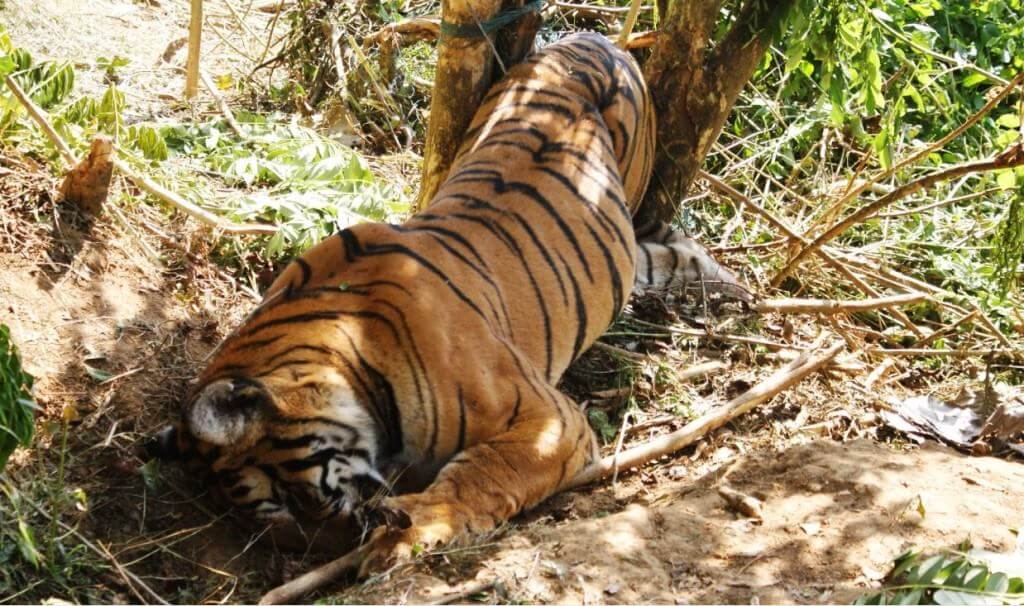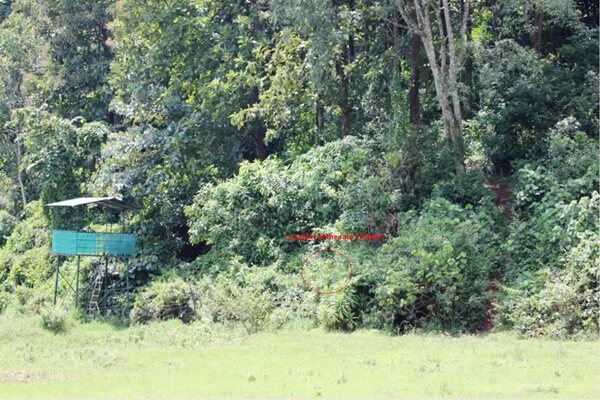Tigers don’t usually give away their presence by roaring, after all, they rely on stealth and they wouldn’t want the prey to know about their whereabouts. There are a few instances where a Tiger would call / roar, it’d call regularly during mating season which is between November and January, and it is quite common to hear the mating calls of the Tiger. These are not roars; these are long-drawn moans rather than the blood-curdling roars. You do once in a while hear the real roars, that is true when there is a territory dispute or when the female is defending her cubs or when it is a shouting match with an elephant, who’d match the roars with thundering trumpets! But during that fateful night in late April, the roars we heard weren’t for any of these reasons.
When you are in the jungle, you sleep light, even the slightest of sounds would wake you up and you are fully alert the very next instant. I remember looking at my watch when I first heard the roar that night, the time read 1:20 am, as I lay in my bed, imagining and wondering why the mighty cat was roaring. I expected the roars to die down in a few minutes, and it was clear that she (it was a Tigress as we later found out) was not exchanging pleasantries, and listening to the roars, we could make out that she was far from happy. I remember walking to the window, listening to those amazing roars, the entire jungle was silent, and that is the effect of the angry roars from a Tiger/Tigress. When the roars continued even after a full 15 minutes, it was clear that something was not right and I remember calling the forest office which was just more than a kilometer away from our farm. The deputy ranger was up as he answered my call on the second ring itself and he said that he could also hear the roar and that it was coming from very close to our farm. Since it was late in the night, we decided that it was better to wait for the first light before venturing out to explore. The deputy forest ranger did mention that it could well be because she was stuck in mud and was unable to move, though I didn’t question him then, I very much doubted this theory at that point in time.
The calls went on till around 3 am, and one thing I noticed was that the power of the call was slowly fading away. Was she actually stuck in a mud pit, unable to free herself? The only way to know for certain was to go in search of her at first light. Needless to say, I was unable to sleep, I remember lying in the bed making a mental map of where the Tigress could be and how best to approach her without alarming her. It was clear that she was around a kilometer to the North-East of the farm, the terrain would be easy to cover because much of the walk would be through the teak plantation. There was a Tribal colony in that area and perhaps we could go there and get a tribal tracker to track her down for us if we had difficulty doing it ourselves.
By 5:30 am, I picked up the Deputy forest ranger from the ranger’s office and drove back to the farm and at first light, by 5:45 am, we started our walk towards where we thought the Tigress had called from earlier that morning. By 4 am, the calls had died down to whimpers and soon it had ceased calling, but we were hoping that the Tigress would still be there, and so we were careful not to alarm her by our approach.
The deputy led the way and we’d stop every now and then to listen for a few minutes for any movement or alarm calls, but the early morning jungle was eerily silent that day. Our target was a ravine which held some water, perhaps the Tigress was there, resting and so keeping the wind direction in mind, we moved carefully towards the ravine. The walk was uneventful and we soon noticed that the river-bed was dry and there was no sign of the Tigress there. The roars had come from around this area, so we decided to walk through the game trail to try and see if we could pick-up any signs of the Tigress.
Tracking in April, just before the rains, is very hard because the earth is dry and so there won’t be any pug-marks to follow. We had to look for broken branches, brushed leaves or grass or even stones that were displaced due to the movement of the animal. The progress was painstakingly slow and we had to ensure that we didn’t keep our feet on the dry teak leaves which would crackle and give away our presence. There was no help from the animals or the birds, no alarm calls or any sort to aid us in our mission.
We had walked for about a kilometer and since we didn’t have any indication as to where the Tigress was, we decided to go towards the tribal colony and quiz the people about the whereabouts of the cat. We were pretty certain that they’d have heard the call all night and perhaps they had a better idea of where the Tigress was. It was a 15 minute walk from where we were and so we took a 90 degree turn and headed in that direction. Since the walk was through the teak plantation, we had good visibility because there won’t be undergrowth in a teak plantation. 5 minutes after we took the 90 degree turn, we reached a small clearing and we could see a wild boar standing ahead of us staring intently at something behind a large Lantana bush. The boar knew that we were there, it’d look at us and then it’d again turn its gaze towards something behind the bush. The Lantana bush was around 10 feet high, 20 feet wide and it was very thick close to our side and so we couldn’t see much into the bush. We both stopped in our tracks and stared into the bush, which was about 40 meters or so from us towards our left. The boar was standing right on the track that we were walking on, and apart from glancing at us, it’d lift its snout up trying to smell what was behind that bush. It was clear that the boar was very nervous, it’d take a few steps back and then come again sniffing, only to jump back and start all over again! This went on for a good 5 minutes and we kept looking intently at the bush and the boar. Something had spooked the boar and it was trying to figure out if it was a threat to him or not.
We didn’t want to continue walking ahead, because the bush was very close to the game trail that we were walking on and whatever was hiding behind that bush would see us coming before we saw it and we’d be at a disadvantage. We exchanged glances and decided that we’d skirt around the bush so that we could have a better look at what the bush was hiding without getting too close to the bush. Without taking our eyes off the bush, we retraced our steps a good 100 meters back and making sure that there was no movement from the bush, we turned left and went inching ahead to see what was out there.
Teak trees are hard to climb because they don’t have lower branches to assist in climbing, so we had to walk closer to the bush to get a better view. We were perhaps 30 meters away from the bush and we could see the boar still standing on the game-trail looking at the bush. It was clear that whatever had caught his attention, was still there. And then we saw what we were searching for. We thought we saw a dark orange object lying down and it was completely motionless. We looked at each other, strained our necks to get a better view and after looking at it carefully for a minute, we could see the unmistakable black stripes on the yellowish-Orange coat behind the Lantana bush. We both froze, and kept looking at the Tigress as she lay completely motionless ahead of us. The initial reaction was to retraces our steps, go back to the forest department and come back with more men to try and see what had happened. As we were considering our options, a common crow which had been sitting on a tree close by all this while decided to swoop down and landed right next to the Tigress! No animal or bird in their right frame of mind would do that. The crow walked right up to where the Tiger was lying and didn’t seem the least bit bothered. We decided to take a few steps back and clap our hands to see if the Tigress would react. We were around 40 meters away from the Tigress and if she woke up, she?d not charge the 40 meters and she was more likely to slink away in the opposite direction. At least that is what we had hoped she’d do. Gathering our courage, we clapped our hands once, but there was no response from the Tigress. We took a small stone and threw it at the bush, we could hear the stone hitting the lantana branch and falling down, and still there was absolutely no movement apart from the crow taking to the air and the boar running off into the jungle.
There was something seriously wrong and we decided to get closer and investigate. Step by step we inched forward, clapping and at times throwing stones into the bush. We were greeted by total silence. It took a good part of 30 minutes for us to cover the next 30 odd meters and we were now just around 10 meters away from the Tigress. We could now see her clearly, lying face down and she hadn’t moved in the last one hour. I picked up a stone and threw it gently at her, and the stone hit her rump, bounced off her and still there was no response from her. It could mean only one thing, the Tigress was dead. I knew something was not right when we heard her call hours back, those angry calls which had given way to whimpers that one wouldn’t associate with such a powerful animal. The calls had gone on for a good 3 hours in the night and in just 5 hours, she had died! What we saw next would remain with me for a very long time; it was perhaps one of the worst sights I have ever seen. We moved a bit more closer and my heart sank when we saw the cause of her death. She was caught in a snare! We could see that there was a small metal wire wound around her waist and it looked as though she had struggled all night to free herself from this metal snare, which instead had tightened around her the more she struggled. I remember sitting down next to this magnificent animal which lay a foot in front of me, and I felt drained and helpless. In front of me lay a magnificent young Tigress perhaps 4 years old, she was in her prime and she had met this untimely death thanks to us humans. She had struggled so hard that part of her left hind leg along with her tail was cut off.
When we go into the jungle, it is not uncommon to find such snares kept around well-used game tracks. It is meant to snare a spotted deer or a wild boar, but snares are indiscriminate and on this occasion, it had snared a beautiful female Tigress in her prime. The answer to ‘who’ had kept the snare is a very open one. It could have been any of the locals residing in that area looking for meat for dinner. The deputy forest ranger was visibly shaken and promised that he’d find the culprit and book him for the crime committed. I wished and hoped that was the case, but it’d still not bring this beautiful Tigress back to life.
I remember sitting close to her, stroking her coarse hair, she was still warm to touch, but lifeless. She’d roar no more…








